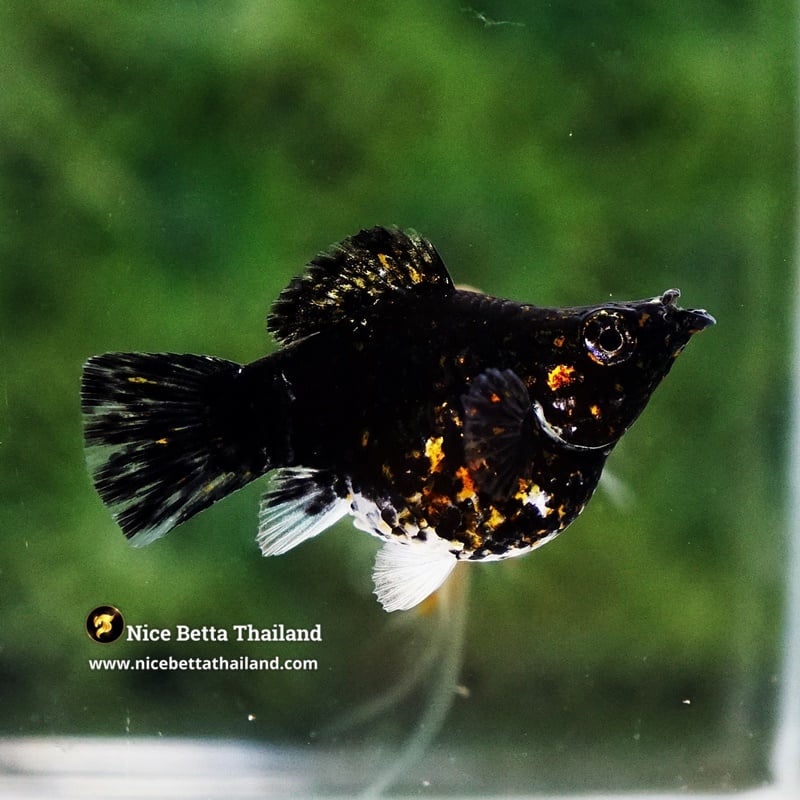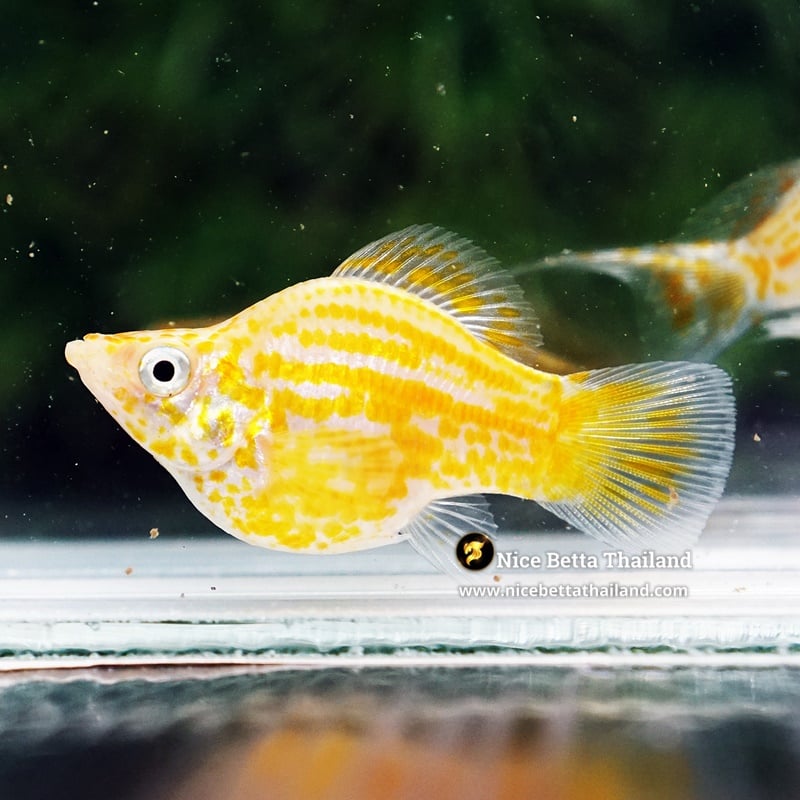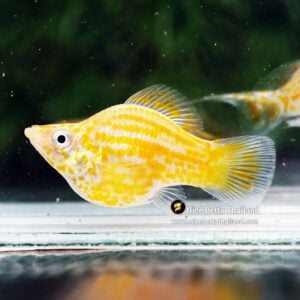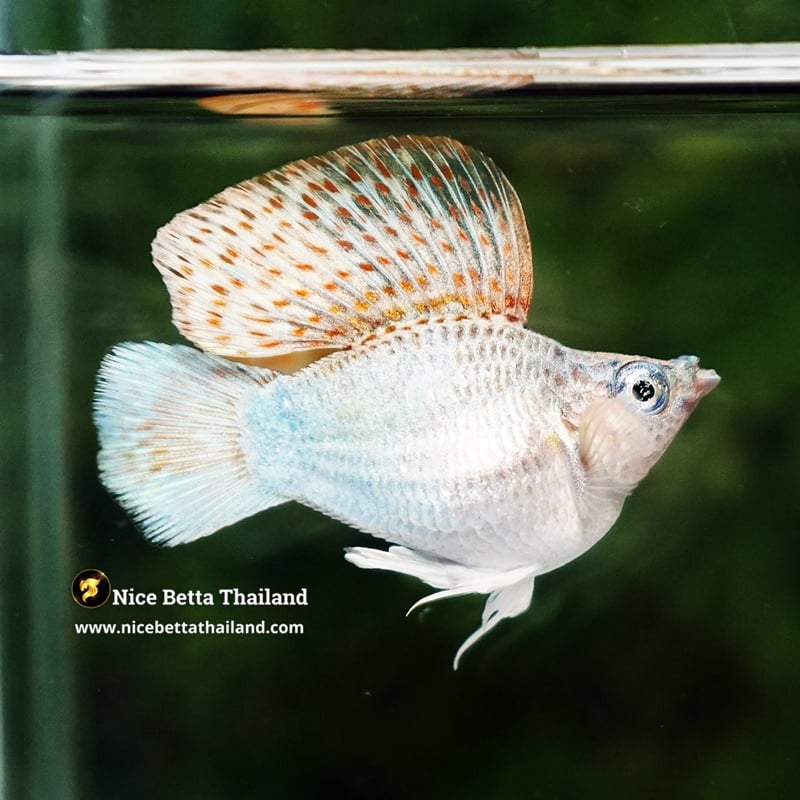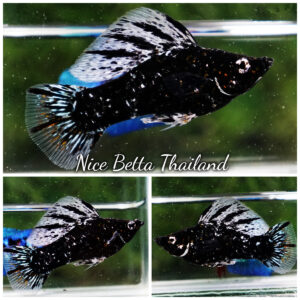Rare Molly fish for sale

What is Molly fish?
These fish are named Molly fish after the original scientific name of their genus, Mollienisia, as it was originally classified in 1846. Since then, the genus has been renamed Poecilia, after the family name Poeciliidae. This genus has some of the most beautiful and unusual varieties of live-bearer fish. The sailfin molly is arguably one of the most exotic fish available of any genus. Other species of mollies have similar appearances, but don’t have the large dorsal sailfin. Mollies come in many color varieties. Mollies are relatively hardy, but prefer warmer aquarium water temperatures. When live-bearers are chilled or otherwise exposed to environmental stress of any kind, they tend to develop an ailment known commonly as “shimmies.” In reality, this is not an infectious disease but merely a compounding of symptoms of stress
Molly fish Species Overview
Common Names: Short-finned molly, sailfin molly, black molly, white molly, golden molly, lyretail molly, dalmatian molly
Scientific Name: Poecilia sp.
Adult Size: Up to 5.5 inches
Life Expectancy: 5 years
Molly fish Characteristics
Amily : Poeciliidae
Origin : South and Central America, Mexico
Social : Peaceful
Tank Level : Mid-dweller
Minimum Tank Size : 20 gallons
Diet : Omnivores
Breeding : Live-bearer
Care : Easy
pH : 7.5 to 8.5
Hardness : 15-30 dGH
Temperature : 78F

Origin and Distribution molly fish
Molly fish are mostly found from Southern United States down into Central America and northern South America. They thrive mainly in freshwater environments, sometimes venturing into brackish estuaries. Mollies, like guppies, are capable of acclimating to full strength sea water temporarily, but it is not their natural environment by any means.
The genus Mollienisia, from which the name mollie was derived, has been re-classified as Poecilia and Mollies are in the same genus as the guppy. For years it had been noticed that the guppy will, under certain circumstances, interbreed with the mollie, and the close relationship between the two has been confirmed genetically
Molly fish colors and markings
All captive mollie species have been interbred for over a century, resulting in many different color varieties and fin shapes. Solid black mollies and sail fin mollies with orange-bordered dorsal fins are common varieties. No other freshwater fish approaches the velvety black color of the black molly. There are also albino forms with red eyes, true lyre tails in most every color, and even chocolate, gold dust and orange varieties. The males of the molly species P. sphenops have short dorsal fins, while the sailfin mollies of the species Poecilia latipinna and P. velifera have very large dorsal fins.
Sailfin Mollies are available in several color varieties. Although these fish breed readily, young raised in tanks may only develop the “sail fin” in a large aquarium. They may also be slightly smaller, reaching only 3.5 inches in length. But raised in a back yard pond, males with a large dorsal sail fin will appear at about 5 months of age, and grow up to 5-6 inches.
An abnormal genetic defect of the spinal cord has produced the Balloon molly. Through selective breeding it is now widely available. Balloon mollies can still reproduce, but may be more susceptible to health problems.
Diet and Feeding for molly fish
In nature, molly fish are nearly exclusively plant and algae eaters, They enjoy eating algae growth in the aquarium, and will graze endlessly on it, looking for choice patches to nibble. If your aquarium lacks algae, you must provide “spirulina” flakes, special commercial Molly food, or small amounts of chopped boiled spinach.
Molly fish Gender Differences
It is easy to determine the gender in Molly fish as males have a prominent gonopodium, a modified anal fin used to inseminate females. Only males have the large dorsal “sail fin” in the species that do have enlarged dorsal fins. The females have a smaller dorsal fin.
The female has a fan-shaped anal fin. In most live-bearers, the pregnant mother swells unmistakably and also presents the well-known “gravid spot,” which is a dark spot near the base of the anal fin. The female carries the fertilized eggs in her body. Each egg contains an embryo and is well furnished with nutritive elements. The eggs hatch within the female and she releases free-swimming babies. There is no parental care exhibited by this species, and the adults will eat the babies if they don’t hide in aquatic plants. They mature quickly and breed readily, with females giving birth to a dozen or more fry every month.

What is Rare Molly fish?
Rare Molly fish? That’s the special unicorn in the Molly world — those unique, uncommon color patterns or fancy fin shapes you don’t see every day. Examples include
- Black molly with unusual markings
- Golden or albino mollies with vivid hues
- Lyretail or sailfin mollies with dramatic, flowing fins
- Hybrid breeds created by breeders that show off rare colors or fin types
They’re rare because either nature didn’t churn them out often, or breeders carefully selected for those traits. If you get one, congrats — you’ve got a flashy, collector-level Molly that’ll make your tank stand out from the crowd.
How to breed Molly fish?
Breeding Molly fish? Easy-peasy, but don’t just throw ‘em in a tank and hope for a miracle. Here’s the no-nonsense, step-by-step guide with a little sass
- Know Your Molly fish Gender
Males are smaller, slimmer, and have a gonopodium (a modified anal fin that looks like a pointy sword).
Females are rounder, bigger, and have a more typical fan-shaped anal fin. - Set Up a Breeding Tank
Clean water, stable temperature around 24-28°C (75-82°F).
pH 7.5 to 8.5 because Mollies love slightly alkaline water.
Provide hiding spots (plants, caves) for the pregnant female and fry.
- Get Healthy Adults molly fish
Put one male with two or more females to reduce male harassment stress.
Feed them high-quality food — mix of flakes, brine shrimp, and veggies
- Courtship & Mating
Males will chase females around, flaunting that gonopodium.
No need to intervene, nature takes its course.
- Pregnancy & Gestation
Female molly gets pregnant for about 4-6 weeks.
You’ll notice her belly getting rounder, darker gravid spot near the rear fin.
- Prepare for Birth
Female molly fish will give birth to live fry (not eggs!) — 20 to 60 tiny babies.
Remove female mollies to a separate tank just before birth or provide dense plants for fry to hide.
- Raise the molly fish Fry
Feed tiny fry crushed flakes, baby brine shrimp, or specialized fry food.
Change water often, keep water clean.
Separate fry if needed to avoid being eaten by adults (cannibalism is a thing).
- Patience and Observation
Molly fish Fry grow fast but need your attention.
After a few weeks, they’re ready to be moved to the main tank or sold/gifted.
Quick reality check: Molly fish breed like rabbits. Once you start, expect babies like a TV soap drama – nonstop. Be prepared, or you’ll drown in tiny fish.
Molly fish summary
Molly fish or molly fish are small freshwater fish that are popular in aquariums. They originated in Central and South America. They have beautiful shapes and come in a variety of colors, such as black, silver, and gold. They are easy to raise and are durable. Males have long dorsal fins and have gonopodium for breeding. Females are larger. Molly fish are livebearers. The gestation period is about 4-6 weeks. The fry are born ready to swim immediately. The mother fish should be separated when it is close to giving birth or a hiding place should be prepared for the fry to prevent them from being eaten. The food for the fry is small food such as shrimp and fine powdered food. Molly fish are suitable for beginners who want to start raising fish because they are easy to care for and can reproduce quickly.


